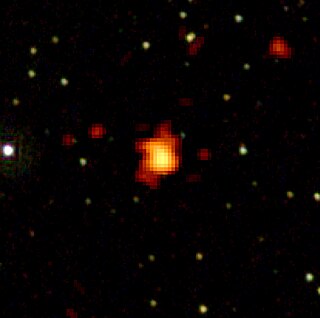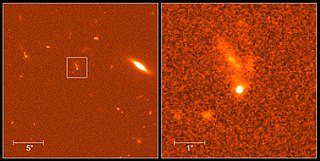
In gamma-ray astronomy, gamma-ray bursts (GRBs) are immensely energetic explosions that have been observed in distant galaxies. They are the brightest and most energetic electromagnetic events known to occur in the universe. Bursts can last from ten milliseconds to several hours. After an initial flash of gamma rays, a longer-lived "afterglow" is usually emitted at longer wavelengths.

The Compton Gamma Ray Observatory (CGRO) was a space observatory detecting photons with energies from 20 keV to 30 GeV, in Earth orbit from 1991 to 2000. The observatory featured four main telescopes in one spacecraft, covering X-rays and gamma rays, including various specialized sub-instruments and detectors. Following 14 years of effort, the observatory was launched from Space Shuttle Atlantis during STS-37 on April 5, 1991, and operated until its deorbit on June 4, 2000. It was deployed in low Earth orbit at 450 km (280 mi) to avoid the Van Allen radiation belt. It was the heaviest astrophysical payload ever flown at that time at 17,000 kilograms (37,000 lb).

The Neil Gehrels Swift Observatory, previously called the Swift Gamma-Ray Burst Mission, is a NASA space observatory designed to detect gamma-ray bursts (GRBs). It was launched on November 20, 2004, aboard a Delta II rocket. Headed by Principal Investigator Neil Gehrels, NASA Goddard Space Flight Center, the mission was developed in a joint partnership between Goddard and an international consortium from the United States, United Kingdom, and Italy. The mission is operated by Pennsylvania State University as part of NASA's Medium Explorers program (MIDEX).

GRB 970228 was the first gamma-ray burst (GRB) for which an afterglow was observed. It was detected on 28 February 1997 at 02:58 UTC. Since 1993, physicists had predicted GRBs to be followed by a lower-energy afterglow, but until this event, GRBs had only been observed in highly luminous bursts of high-energy gamma rays ; this resulted in large positional uncertainties which left their nature very unclear.

PROMPT, an acronym for Panchromatic Robotic Optical Monitoring and Polarimetry Telescopes, is being built by the University of North Carolina at Chapel Hill at Cerro Tololo Inter-American Observatory (CTIO) in Chile. PROMPT's primary objective is rapid and simultaneous multiwavelength observations of gamma-ray burst afterglows, some when they are only tens of seconds old. In addition to measuring redshifts by dropout, and early-time SFDs and extinction curves of sufficiently bright afterglows in unprecedented detail, PROMPT will facilitate quick response observations at larger observatories such as the UNC-led 4.1-m SOAR Telescope. PROMPT will also serve as a platform for undergraduate and high school education throughout the State of North Carolina.

GRB 080916C is a gamma-ray burst (GRB) that was recorded on September 16, 2008 in the Carina constellation and detected by NASA's Fermi Gamma-ray Space Telescope. It is the most powerful gamma-ray burst ever recorded. The explosion had the energy of approximately 5900 type Ia supernovae, and the gas jets emitting the initial gamma rays moved at a minimum velocity of approximately 299,792,158 m/s (0.999999c), making this blast the most extreme recorded to date.

The Gamma-Ray Burst Optical/Near-Infrared Detector (GROND) is an imaging instrument used to investigate Gamma-Ray Burst afterglows and for doing follow-up observations on exoplanets using transit photometry. It is operated at the 2.2-metre MPG/ESO telescope at ESO's La Silla Observatory in the southern part of the Atacama desert, about 600 kilometres north of Santiago de Chile and at an altitude of 2,400 metres.

GRB 970508 was a gamma-ray burst (GRB) detected on May 8, 1997, at 21:42 UTC; it is historically important as the second GRB with a detected afterglow at other wavelengths, the first to have a direct redshift measurement of the afterglow, and the first to be detected at radio wavelengths.

GRB 990123 is a gamma-ray burst which was detected on January 23, 1999. It was the first GRB for which a simultaneous optical flash was detected. Astronomers first managed to obtain a visible-light image of a GRB as it occurred on January 23, 1999, using the ROTSE-I telescope in Los Alamos, New Mexico. The ROTSE-I was operated by a team under Dr. Carl W. Akerlof of the University of Michigan and included members from Los Alamos National Laboratory and Lawrence Livermore National Laboratory. The robotic telescope was fully automated, responding to signals from NASA's BATSE instrument aboard the Compton Gamma Ray Observatory within seconds, without human intervention. In the dark hours of the morning of January 23, 1999, the Compton satellite recorded a gamma-ray burst that lasted for about a minute and a half. There was a peak of gamma and X-ray emission 25 seconds after the event was first detected, followed by a somewhat smaller peak 40 seconds after the beginning of the event. The emission then fizzled out in a series of small peaks over the next 50 seconds, and eight minutes after the event had faded to a hundredth of its maximum brightness. The burst was so strong that it ranked in the top 2% of all bursts detected.
GRB 000131 was a gamma-ray burst (GRB) that was detected on 31 January 2000 at 14:59 UTC. A gamma-ray burst is a highly luminous flash associated with an explosion in a distant galaxy and producing gamma rays, the most energetic form of electromagnetic radiation, and often followed by a longer-lived "afterglow" emitted at longer wavelengths.
GRB 020813 was a gamma-ray burst (GRB) that was detected on 13 August 2002 at 02:44 UTC. A gamma-ray burst is a highly luminous flash associated with an explosion in a distant galaxy and producing gamma rays, the most energetic form of electromagnetic radiation, and often followed by a longer-lived "afterglow" emitted at longer wavelengths.
GRB 030329 was a gamma-ray burst (GRB) that was detected on 29 March 2003 at 11:37 UTC. A gamma-ray burst is a highly luminous flash associated with an explosion in a distant galaxy and producing gamma rays, the most energetic form of electromagnetic radiation, and often followed by a longer-lived "afterglow" emitted at longer wavelengths. GRB 030329 was the first burst whose afterglow definitively exhibited characteristics of a supernova, confirming the existence of a relationship between the two phenomena.
The Robotic Optical Transient Search Experiment (ROTSE) is a multi-telescope experiment designed to observe the optical afterglow of gamma-ray bursts. The experiment currently consists of four telescopes located in Australia, Namibia, Turkey, and at the McDonald Observatory near Fort Davis, Texas.

GRB 090429B was a gamma-ray burst observed on 29 April 2009 by the Burst Alert Telescope aboard the Swift satellite. The burst triggered a standard burst-response observation sequence, which started 106 seconds after the burst. The X-ray telescope aboard the satellite identified an uncatalogued fading source. No optical or UV counterpart was seen in the UV–optical telescope. Around 2.5 hours after the burst trigger, a series of observations was carried out by the Gemini North telescope, which detected a bright object in the infrared part of the spectrum. No evidence of a host galaxy was found either by Gemini North or by the Hubble Space Telescope. Though this burst was detected in 2009, it was not until May 2011 that its distance estimate of 13.14 billion light-years was announced. With 90% likelihood, the burst had a photometric redshift greater than z = 9.06, which would make it the most distant GRB known, although the error bar on this estimate is large, providing a lower limit of z > 7.

GRB 101225A, also known as the "Christmas burst", was a cosmic explosion first detected by NASA's Swift observatory on Christmas Day 2010. The gamma-ray emission lasted at least 28 minutes, which is unusually long. Follow-up observations of the burst's afterglow by the Hubble Space Telescope and ground-based observatories were unable to determine the object's distance using spectroscopic methods.
The Livermore Optical Transient Imaging System, or LOTIS, is an automated telescope designed to slew very rapidly to the location of gamma-ray bursts (GRBs), to enable the simultaneous measurement of optical counterparts. Since GRBs can occur anywhere in the sky, are often poorly localized, and fade very quickly, this implies very rapid slewing and a wide field of view. To achieve the needed response time, LOTIS was fully automated and connected via Internet socket to the Gamma-ray Burst Coordinates Network. This network analyzes telemetry from satellite such as HETE-2 and Swift Gamma-Ray Burst Mission and delivers GRB coordinate information in real-time.. The optics were built from 4 commercial tele-photo lenses of 11 cm aperture, with custom 2048 X 2048 CCD cameras, and could view a 17.6 X 17.6 degree field.
Super-LOTIS is the second incarnation of the Livermore Optical Transient Imaging System, located at the Steward Observatory on Kitt Peak. It is an automated telescope designed to slew very rapidly to the location of gamma-ray bursts (GRBs), to enable the simultaneous measurement of optical counterparts. GRBs can occur anywhere in the sky, fade very quickly, and were initially poorly localized, so the original LOTIS needed very rapid slewing and an extremely wide field of view. However, this wide field of view meant it could not see faint sources, and only the brightest GRB afterglows could be studied.

GRB 130427A was a record-setting gamma-ray burst, discovered starting on April 27, 2013. This GRB was associated to SN 2013cq, of which the appearance of optical signal was predicted on May 2, 2013 and detected on May 13, 2013. The Fermi space observatory detected a gamma-ray with an energy of at least 94 billion electron volts. It was simultaneously detected by the Burst Alert Telescope aboard the Swift telescope and was the brightest burst Swift had ever detected. It was one of the five closest GRBs, at about 3.6 billion light-years away, and was comparatively long-lasting.
Fermi's Large Area Telescope (LAT) recorded one gamma ray with an energy of at least 94 billion electron volts (GeV), or some 35 billion times the energy of visible light, and about three times greater than the LAT's previous record. The GeV emission from the burst lasted for hours, and it remained detectable by the LAT for the better part of a day, setting a new record for the longest gamma-ray emission from a GRB.
The Space Variable Objects Monitor (SVOM) is a planned small X-ray telescope satellite under development by China National Space Administration (CNSA) and the French Space Agency (CNES), to be launched in June 2022.

Mikhailo Lomonosov is an astronomical satellite operated by Moscow State University (MSU) named after Mikhail Lomonosov.














